Ziyu Ma
DrVideo: Document Retrieval Based Long Video Understanding
Jun 18, 2024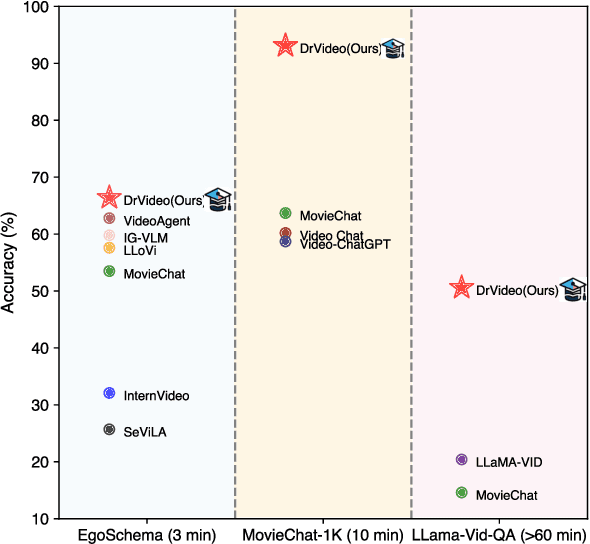
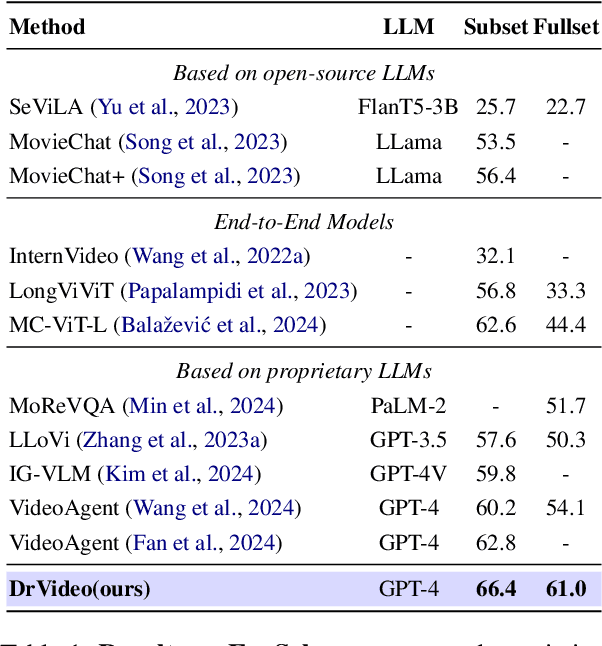
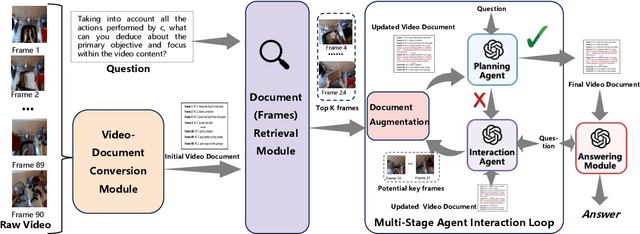
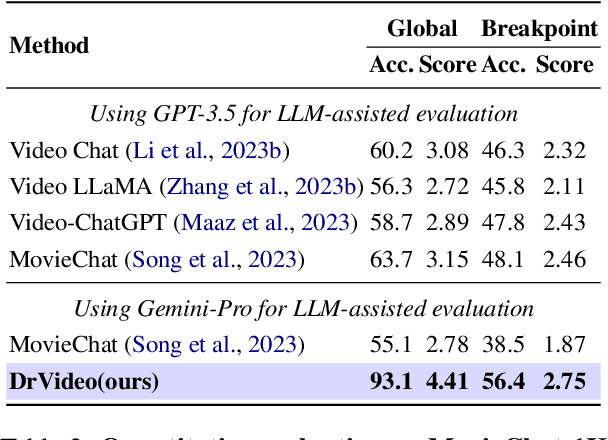
Abstract:Existing methods for long video understanding primarily focus on videos only lasting tens of seconds, with limited exploration of techniques for handling longer videos. The increased number of frames in longer videos presents two main challenges: difficulty in locating key information and performing long-range reasoning. Thus, we propose DrVideo, a document-retrieval-based system designed for long video understanding. Our key idea is to convert the long-video understanding problem into a long-document understanding task so as to effectively leverage the power of large language models. Specifically, DrVideo transforms a long video into a text-based long document to initially retrieve key frames and augment the information of these frames, which is used this as the system's starting point. It then employs an agent-based iterative loop to continuously search for missing information, augment relevant data, and provide final predictions in a chain-of-thought manner once sufficient question-related information is gathered. Extensive experiments on long video benchmarks confirm the effectiveness of our method. DrVideo outperforms existing state-of-the-art methods with +3.8 accuracy on EgoSchema benchmark (3 minutes), +17.9 in MovieChat-1K break mode, +38.0 in MovieChat-1K global mode (10 minutes), and +30.2 on the LLama-Vid QA dataset (over 60 minutes).
GeReA: Question-Aware Prompt Captions for Knowledge-based Visual Question Answering
Feb 04, 2024Abstract:Knowledge-based visual question answering (VQA) requires world knowledge beyond the image for accurate answer. Recently, instead of extra knowledge bases, a large language model (LLM) like GPT-3 is activated as an implicit knowledge engine to jointly acquire and reason the necessary knowledge for answering by converting images into textual information (e.g., captions and answer candidates). However, such conversion may introduce irrelevant information, which causes the LLM to misinterpret images and ignore visual details crucial for accurate knowledge. We argue that multimodal large language model (MLLM) is a better implicit knowledge engine than the LLM for its superior capability of visual understanding. Despite this, how to activate the capacity of MLLM as the implicit knowledge engine has not been explored yet. Therefore, we propose GeReA, a generate-reason framework that prompts a MLLM like InstructBLIP with question relevant vision and language information to generate knowledge-relevant descriptions and reasons those descriptions for knowledge-based VQA. Specifically, the question-relevant image regions and question-specific manual prompts are encoded in the MLLM to generate the knowledge relevant descriptions, referred to as question-aware prompt captions. After that, the question-aware prompt captions, image-question pair, and similar samples are sent into the multi-modal reasoning model to learn a joint knowledge-image-question representation for answer prediction. GeReA unlocks the use of MLLM as the implicit knowledge engine, surpassing all previous state-of-the-art methods on OK-VQA and A-OKVQA datasets, with test accuracies of 66.5% and 63.3% respectively. Our code will be released at https://github.com/Upper9527/GeReA.
Scene-Aware Prompt for Multi-modal Dialogue Understanding and Generation
Jul 05, 2022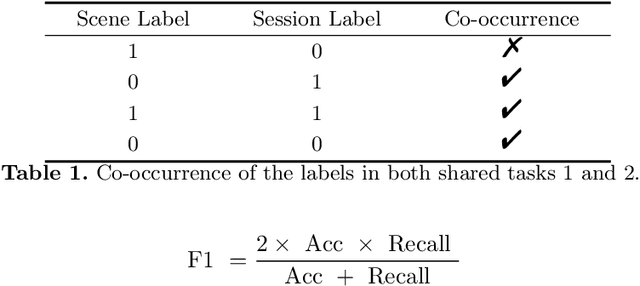
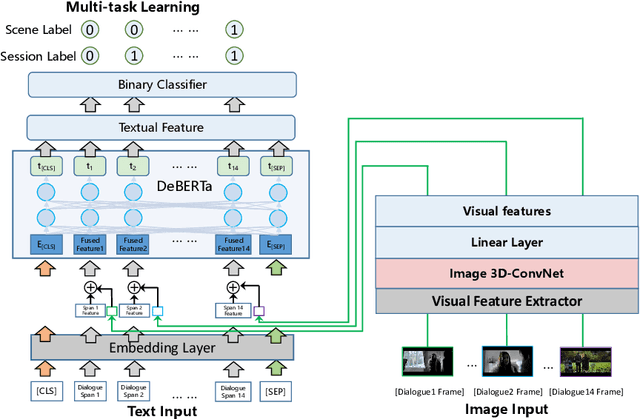
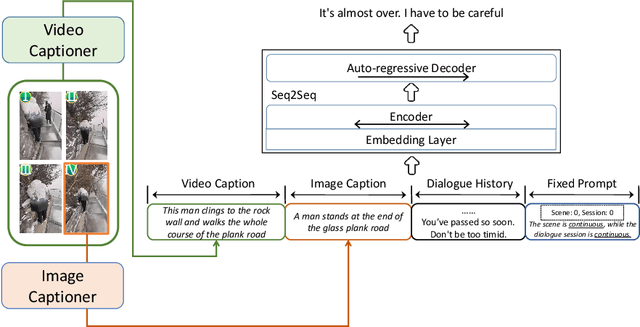

Abstract:This paper introduces the schemes of Team LingJing's experiments in NLPCC-2022-Shared-Task-4 Multi-modal Dialogue Understanding and Generation (MDUG). The MDUG task can be divided into two phases: multi-modal context understanding and response generation. To fully leverage the visual information for both scene understanding and dialogue generation, we propose the scene-aware prompt for the MDUG task. Specifically, we utilize the multi-tasking strategy for jointly modelling the scene- and session- multi-modal understanding. The visual captions are adopted to aware the scene information, while the fixed-type templated prompt based on the scene- and session-aware labels are used to further improve the dialogue generation performance. Extensive experimental results show that the proposed method has achieved state-of-the-art (SOTA) performance compared with other competitive methods, where we rank the 1-st in all three subtasks in this MDUG competition.
Hybrid Mutimodal Fusion for Dimensional Emotion Recognition
Oct 16, 2021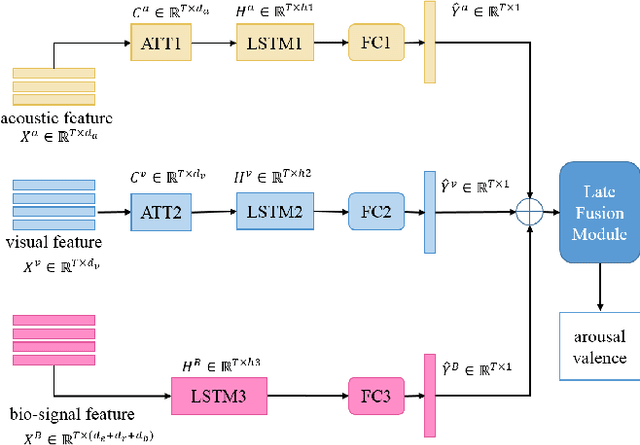
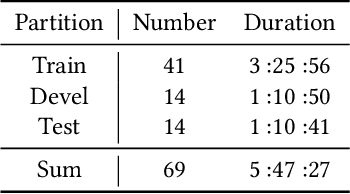
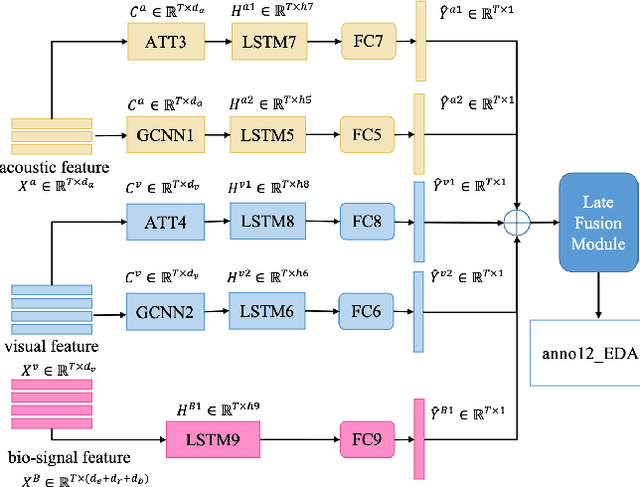
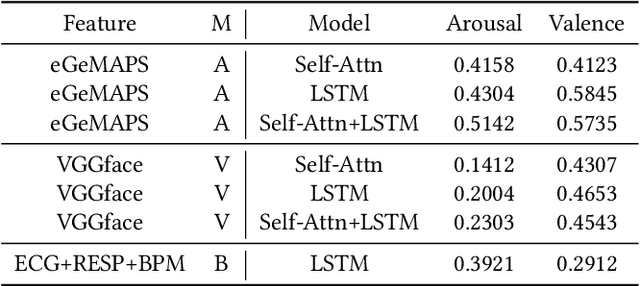
Abstract:In this paper, we extensively present our solutions for the MuSe-Stress sub-challenge and the MuSe-Physio sub-challenge of Multimodal Sentiment Challenge (MuSe) 2021. The goal of MuSe-Stress sub-challenge is to predict the level of emotional arousal and valence in a time-continuous manner from audio-visual recordings and the goal of MuSe-Physio sub-challenge is to predict the level of psycho-physiological arousal from a) human annotations fused with b) galvanic skin response (also known as Electrodermal Activity (EDA)) signals from the stressed people. The Ulm-TSST dataset which is a novel subset of the audio-visual textual Ulm-Trier Social Stress dataset that features German speakers in a Trier Social Stress Test (TSST) induced stress situation is used in both sub-challenges. For the MuSe-Stress sub-challenge, we highlight our solutions in three aspects: 1) the audio-visual features and the bio-signal features are used for emotional state recognition. 2) the Long Short-Term Memory (LSTM) with the self-attention mechanism is utilized to capture complex temporal dependencies within the feature sequences. 3) the late fusion strategy is adopted to further boost the model's recognition performance by exploiting complementary information scattered across multimodal sequences. Our proposed model achieves CCC of 0.6159 and 0.4609 for valence and arousal respectively on the test set, which both rank in the top 3. For the MuSe-Physio sub-challenge, we first extract the audio-visual features and the bio-signal features from multiple modalities. Then, the LSTM module with the self-attention mechanism, and the Gated Convolutional Neural Networks (GCNN) as well as the LSTM network are utilized for modeling the complex temporal dependencies in the sequence. Finally, the late fusion strategy is used. Our proposed method also achieves CCC of 0.5412 on the test set, which ranks in the top 3.
 Add to Chrome
Add to Chrome Add to Firefox
Add to Firefox Add to Edge
Add to Edge